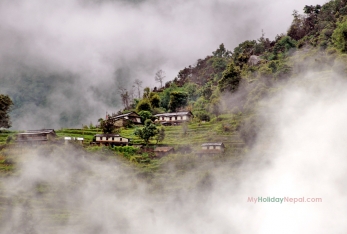Weather Facts

Here climate varies from cool summers and severe winters in north to subtropical summers and mild winters in south. Nepal has a great deal of variation in climate. Nepal experiences four seasons of climate spring, summer, autumn and winter. The climate is varied ranging from the sub-tropical Terai to the cool dry temperature and alpine climates in the northern Himalayan ranges.
In the Terai, the hottest part of the country, summer temperatures may rise as high as 40OC. the climate is hot and humid. Rainfall is wide spread during the south-west monsoon period from June to August with the eastern part receiving the maximum rainfall. The period from October to May is generally dry in most parts of the country. Annual precipitation varies from around 300 mm in the northern and western areas to over 250 mm in the eastern regions. Kathmandu valley receives around 1300 mm of annual rainfall with a heavy concentration from June to August. Its latitude is about the same as that of Florida, and a tropical and subtropical climate exists in the Terai Region.
Outside the Terai, however, the climate is completely different. The remarkable differences in climatic conditions are primarily related to the enormous range of altitude within such a short north-south distance. The presence of the east-west-trending Himalayan massifs to the north and the monsoonal alteration of wet and dry seasons also greatly contribute to local variations in climate.
Scholar Sharad Singh Negi identifies five climatic zones in Nepal based on altitude:
• the tropical and subtropical zone of below 1,200 meters in altitude;
• the cool, temperate zone of 1,200 to 2,400 meters in altitude;
• the cold zone of 2,400 to 3,600 meters in altitude;
• the subarctic climatic zone of 3,600 to 4,400 meters in altitude and
• the arctic zone above 4,400 meters in altitude.
In terms of natural vegetation regimes or distribution patterns, altitude again plays a significant role. Below 1,200 meters, the dominant form of vegetation consists of tropical and subtropical rain forests.
Altitude also affects annual rainfall or precipitation patterns. Up to about 3,000 meters, annual rainfall totals increase as the altitude increases; thereafter, annual totals diminish with increasing altitude and latitude. In addition to this latitudinal differentiation in rainfall, two other patterns can be discerned. First, given the northwestward movement of the moisture-laden summer monsoon (June to September), the amount of annual rainfall generally decreases from east to west. However, there are certain pockets with heavy annual rainfall totals, for example, the Pokhara Valley in central Nepal. Second, the horizontal extension of hill and mountain ranges creates a moist condition on south and eastfacing slopes whereas it produces a major rain shadow on the northern sides of the slopes. The aridity increases with altitude and latitude, especially on the northern slopes, and reaches its climax in the inner Himalayan region and on the Tibetan Plateau. Eastern Nepal receives approximately 2,500 millimeters of rain annually, the Kathmandu area about 1,420 millimeters, and western Nepal about 1,000 millimeters.
The towering Himalayas play a critical role, blocking the northwesterly advances of moist, tropical air from the Bay of Bengal, and ultimately leading to its conversion to rain in the summer. In the winter, this range prevents the outbursts of cold air from Inner Asia from reaching southern Nepal and northern India, thus ensuring warmer winters in these regions than otherwise would be the case.
In addition, there are seasonal variations in the amount of rainfall, depending on the monsoon cycle. Bishop divides the monsoon cycle into four seasons: premonsoon, summer monsoon, postmonsoon, and winter monsoon. The premonsoon season generally occurs during April and May; it is characterized by the highest temperatures, reaching 40° C during the day in the Terai Region and other lowlands. The hills and mountains, however, remain cool.
The summer monsoon, a strong flow of moist air from the southwest, follows the pre-monsoon season. For the vast majority of southern Asians, including Nepalese, the term monsoon is synonymous with the summer rainy season, which makes or breaks the lives of hundreds of millions of farmers on the subcontinent. Even though the arrival of the summer monsoon can vary by as much as a month, in Nepal it generally arrives in early June, is preceded by violent lightning and thunderstorms, and lasts through September, when it begins to recede. The plains and lower Himalayas receive more than 70 percent of their annual precipitation during the summer monsoon. The amount of summer monsoon rain generally declines from southeast to northwest as the maritime wedge of air gradually becomes thinner and dryer. Although the success of farming is almost totally dependent on the timely arrival of the summer monsoon, it periodically causes such problems as landslides; subsequent losses of human lives, farmlands, and other properties (not to mention great difficulty in the movement of goods and people); and heavy flooding in the plains. Conversely, when prolonged breaks in the summer monsoon occur, severe drought and famine often result.
The post monsoon season begins with a slow withdrawal of the monsoon. This retreat leads to an almost complete disappearance of moist air by mid-October, thus ushering in generally cool, clear, and dry weather, as well as the most relaxed and jovial period in Nepal. By this time, the harvest is completed and people are in a festive mood. The two biggest and most important Hindu festivals-- Dashain and Tihar (Dipawali)--arrive during this period, about one month apart. The post monsoon season lasts until about December.
After the post monsoon, comes the winter monsoon, a strong northeasterly flow, which is marked by occasional, short rainfalls in the lowlands and plains and snowfalls in the high-altitude areas. The amount of precipitation resulting from the northeast land trade winds varies considerably but increases markedly with elevation. The secondary winter precipitation in the form of snowfalls in the Himalayas is important for generating a sufficient volume of spring and summer meltwaters, which are critical for irrigation in the lower hills and valleys where agriculture predominates. Winter precipitation is also are indispensable for the success of winter crops, such as wheat, barley, and numerous vegetables.
Nepal has four distinct seasons. Spring, from March to May is warm and dusty with rain showers. Summer, from June to August, is the monsoon season when the hills turn lush and green. Autumn, from September to November, is cool with clear skies, and is the most popular trekking season. In winter from December to February, it is cold at night and can be foggy in the early morning but afternoons are usually clear and pleasant, though there is occasional snow in the mountains.
Weather condition in Nepal vary from region to region. Summer and late spring temperatures range from more than 40 Degrees Celsius in the Terai to about 28 Degrees Celsius in the hilly region of the country. In winter, average maximum and minimum temperatures in the Terai range from a mild 23 Degrees Celsius to a brisk 7 Degrees Celsius while the central valleys experience a chilly 12 Degrees Celsius maximum temperature and a minimum temperature often falling below freezing point.
Much colder temperatures prevail at higher elevations. The Katmandu Valley situated at an altitude of 1310m, has a seasonable but equable climate with average summer and winter temperatures of 27 Degrees Celsius to 19 Degrees Celsius and 20 Degrees Celsius to 2 Degrees Celsius respectively. The annual rainfall in Katmandu generally exceeds 1300mm. The mean annual precipitation ranges from more than 6000mm along the southern slopes of the Annapurna range in central Nepal to less than the 250mm in the north central portion near the Tibetan plateau. Amounts varying between 1500 and 2500mm predominate over most of the country. On an average, about 80% of the precipitation is confined to the monsoon period (June-September).
Best Seasonality
Arrival figures to most destinations show that for the Nepalese tourists is preferred dry season from October to November. The weather is balmy, the air is clean, visibility is perfect and the countryside is lush and green following the monsoon. October is the time for festivals in Nepal. From February until April, the tail end of the dry season is the second-best period. December and January is not recommended for travelling in Nepal.
The rest of the year is fairly unpleasant for travelling: May and early June are generally too hot and dusty for comfort, and the monsoon from mid-June to September obscures the mountains in cloud and turns trails and roads to mud. Flying is often the only way to reach outlying areas at this time of year, and the western border crossings to India are often impassable.
Best Places to Visit
Trekking and More
Temples ,Stupas and more
News & Event
-

NOBUKAZU KURIKI WILL BE THE FIRST AND ONLY CLIMBER ATTEMPTING TO SUMMIT EVEREST THIS SEASON
Sep 17, 2015 to Sep 17, 2015 read more »
-

FREE BUS RIDE TO BHAKTAPUR ON THE OCCASION OF GAIJATRA
Aug 28, 2015 read more »
-

KATHMANDU TO BANGLORE, MUMBAI DIRECT FLIGHT
Aug 15, 2015 to Aug 16, 2015 read more »
-

DAMAGE ASSESSMENT OF ANNAPURNA REGION
Jul 01, 2015 to Jul 01, 2015 read more »

Tourist Information

























